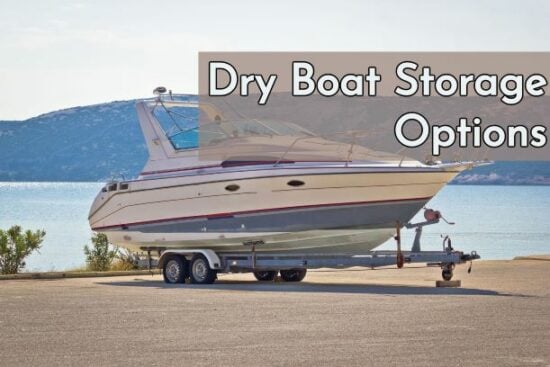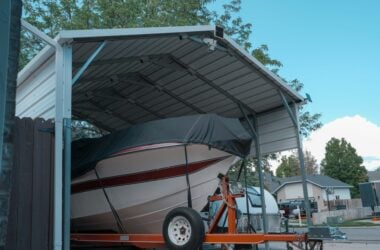As a boat owner, you need a hassle-free and effective way to store your beloved vessel. One of the safest storage options is dry boat storage. Dry boat storage, also known as “dry stack storage” or “dry docking”, is a specially designed facility to store boats on land instead of in a marina slip or trailer.
The main reason to consider dry boat storage—over all other boat storage options—is that constant water exposure could lead to hull damage, waterline grime, and more.
While you could store your watercraft using outdoor storage solutions, drastic fluctuations in temperatures can also cause the wood trimming to expand and contract. This can result in the splitting, warping, and even rotting of a boat’s structures.
Therefore, the best option is to store your boats in a dry storage unit offered on platforms like Neighbor. Not only do these storages protect your craft from natural calamities, but they also prevent theft.
What is Dry Boat Storage?
In dry boat storage facilities, vessels are stored on racks or cradles to protect them from outside elements and potential water-related issues. Because boats are lifted in and out of the water using a forklift or crane system, you can still easily access your watercraft whenever you want to use it.
This storage method is particularly popular in areas with seasonal boating or where water-related issues can arise.
By keeping boats dry and sheltered in a controlled environment, you can extend the life of your boat, make maintenance more manageable, and enjoy a hassle-free sailing experience.
Difference Between Wet Slips vs Dry Storage
Wet slip storage is the space between marina walkways where boats are stored, giving you immediate access to vessels for spontaneous outings. However, this convenience comes with prolonged exposure to moisture, resulting in fouling, marine growth (like algae and aquatic weeds), and potential damage from wave action.
In comparison, retrieving a boat from dry storage takes some time, but it offers protection against all issues caused by constant water exposure. Moreover, storing your boat at a wet slip costs more than dry storage.
For a storage spot in a wet slip, you must pay up to $42 per foot for a month. However, the final cost depends on your location and boat size. In contrast, you can secure a dry stack of 20 feet in the range of $50 to $150 on storage marketplaces (such as Neighbor).
Types of Dry Boat Storage
Dry boat storage is divided into multiple types, and you can choose one that is more feasible for you.
- Dry Stack Storage: Boats are vertically stored on racks in a covered and temperature-controlled storage facility by using a forklift or crane system. This storage option is better to use in both warm and cold areas like California, Texas, Florida, Chicago, and Lake Tahoe.
- Trailer Storage: Boats are stored in an outdoor trailer that is placed in a designated area. It is a more cost-effective option but does not offer the same level of protection as covered storage.
- Boat Yards: Boats are stored on land, ranging from open spaces to covered storage sheds. It is an affordable storage option compared to marinas.
- Self-Storage Units: Boat owners can rent self-storage units specifically designed for boats with platforms like Neighbor. These units vary in size and can be situated indoors or outdoors.
- Boat Shelters: Custom-built boat shelters are temporary or permanent structures that boat owners build on their property to protect boats from all types of weather.
How Much Does Dry Boat Storage Cost?
The cost of dry storage of a boat varies depending on your vessel’s type, size, and availability. The final cost also depends on the selected storage option and availed facilities. However, you can check the price of different storage to decide which fits your budget.
Rack Storage
Source: Pixabay
Rack storage is the most expensive boat storage option, as you have to pay according to the size of your boat. The fee can vary from $50 to $250 per month if you find the rack storage from an affordable marketplace like Neighbor.
Marina Storage
Some marinas and lakes offer dry storage on docks without using the racking method. The charges for this storage are based on the size of the boat and your selected dock. For example, Marina Bay Harbor charges $357.50 for a 20-foot boat, and the charges double on the weekend.
The plus side of this storage facility is that you don’t have to wait to take your watercraft for a sail. You can call the marina and ask them to ready your vessel, so you’ll be prepared to set sail on your voyage head.
Storage Unit
Boat storage units are individual enclosed spaces on land to store your sailing craft safely. If you have a small boat, you must get a 10×15 unit. However, if you’re looking for bigger vessels, you will need a 10×20 or 10×30 unit.
You can get a small unit for $75, a medium unit for $150, and a large unit for $300. However, the charges can increase if you are choosing a climate-controlled unit. To correctly calculate the cost, you can review the storage cost guide. It can help you estimate the right rates based on several factors.
Otherwise, you can search online and find a storage marketplace like Neighbor that offers economical storage units all across the US. There, you can select a unit that is suitable for winter months to keep your vessel throughout the year.
Garage or Driveway Storage
Some cities permit boat storage in driveways, sideyards, and backyards. While home storage is the most affordable option, as you don’t have to pay any rent, this lower cost isn’t without its trade-offs.
Should you choose to store your boat in your driveway for the long term, your watercraft will be exposed to the elements, spiking your risk of your boat sustaining weather-related damage. Additionally, you can be charged a fine for keeping a boat in your driveway for extended periods if you live in an HOA community.
Final Thoughts
While dry boat storage is far more costly than shrink-wrapping, you can’t put a price on peace of mind. If you live in an area known for its brutal winters and dramatic season changes, dry boat storage is a must.
FAQs
What is the best way to store a boat outside?
If you can’t find (or can’t afford) dry boat storage options, the best way to store a boat outside is by wrapping it in a custom-fit tarp.
Is it better to keep a boat in or out of water?
It is advisable not to store a boat in the water as changing water levels, storms, and high winds can damage the dock.
How do I keep my boat storage dry?
You can keep your boat storage dry by cleaning off all excess water from the vessel outside of the storage.









